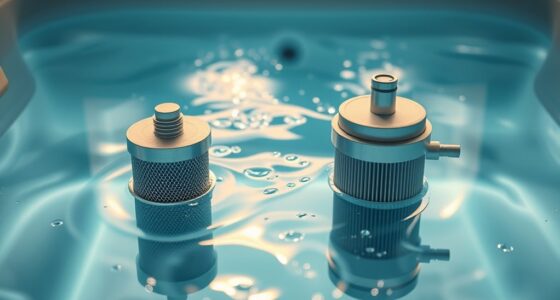When choosing water testing tools, test strips are simple and quick, ideal for routine checks like pools or small water sources. Digital meters offer more precise, numerical results, making them suitable for professional or safety-critical testing. Test strips are affordable and easy to use but less accurate, while digital meters require calibration but provide reliable data. To find the best option for your needs, keep exploring further details ahead.
Key Takeaways
- Test strips offer quick, easy water testing with minimal training, ideal for routine checks, while digital meters provide precise, numerical results for detailed analysis.
- Digital meters generally deliver higher accuracy and reliability but require calibration and maintenance; test strips are more convenient but less precise.
- Test strips are cost-effective and suitable for frequent, casual testing; digital meters involve higher upfront costs but are preferred for professional or safety-critical applications.
- For quick, on-the-spot assessments, test strips are preferred; digital meters are better suited for environments demanding exact measurements.
- Choosing between them depends on balancing ease and speed versus long-term accuracy and detailed data needs.

Water testing tools are essential for guaranteeing the safety and quality of your water supply. Whether you’re maintaining a home aquaponics system, swimming pool, or ensuring well water safety, choosing the right testing method makes all the difference. Two common options are test strips and digital meters, each with its own advantages and limitations. Understanding their differences can help you decide which tool suits your needs best.
Test strips are straightforward and affordable. They typically involve dipping a strip into water and comparing the color change against a chart. For pH measurement, these strips change color based on the water’s acidity or alkalinity, giving you a quick visual indication. When it comes to chlorine detection, test strips are equally convenient; they react with free chlorine and produce a color change that indicates chlorine levels. These strips are perfect for quick, on-the-spot testing, especially when you need immediate results without much hassle. They’re portable, easy to use, and ideal for frequent testing, making them popular among homeowners and hobbyists. However, their accuracy can vary, especially if the color interpretation is subjective or if the strips are stored improperly.
Digital meters, on the other hand, offer a more precise and dependable approach. They often utilize probes that you immerse in water, providing real-time digital readings for pH measurement and chlorine detection. The accuracy of digital meters is generally higher than test strips, especially when regular calibration is performed. With digital meters, you get numerical results, reducing the guesswork involved with color interpretation. This precision is critical if you’re managing sensitive environments, such as laboratory settings or large-scale aquaculture operations. Digital meters tend to be more durable and consistent over time, but they come with a higher upfront cost and require proper maintenance, including calibration and battery replacement. They are less portable than test strips but excel in providing detailed, dependable data.
Ultimately, your choice depends on your specific needs. If you require quick, simple checks and are okay with slightly less precision, test strips are a practical option. They’re especially handy for routine monitoring, like weekly pool testing or checking small water supplies. If accuracy, consistency, and detailed data are indispensable—say, for professional or health-related reasons—digital meters are worth the investment. They allow you to track subtle changes in pH levels and chlorine concentrations, which can be essential for safety and compliance. Both tools serve their purpose well, but knowing their strengths and limitations ensures you select the right water testing tool for your situation.
Frequently Asked Questions
How Often Should I Test My Water Quality?
You should test your water quality at least once a month for routine monitoring, but adjust based on seasonal testing needs. During heavy rain or drought, increase testing frequency to catch potential issues. Regular testing helps you catch problems early, especially if you notice changes in water appearance or taste. Using test strips or digital meters makes this process quick and effective, ensuring your water stays safe year-round.
Are Digital Meters More Accurate Than Test Strips?
Digital meters are like precision tools in your hands, offering greater accuracy than test strips. They measure water quality with consistent precision, making them more reliable for critical testing. Plus, they’re user-friendly, providing quick, clear results without guesswork. While test strips are convenient and inexpensive, digital meters guarantee you get precise data, especially when monitoring for health or safety concerns. So, if accuracy matters most, digital meters are the better choice.
What Is the Cost Difference Between Test Strips and Digital Meters?
You’ll find that test strips are generally more affordable upfront, costing just a few dollars for a pack, making them a budget-friendly choice. Digital meters, on the other hand, usually have a higher initial price, often ranging from $20 to over $100, depending on features. The pricing comparison shows test strips are more affordable, but digital meters can be more cost-effective long-term if you need frequent testing, according to an affordability analysis.
Can Test Strips Detect All Water Contaminants?
Think of test strips as a flashlight in a dark room—they reveal some contaminants, but not everything. They have limitations and can’t detect all water contaminants. Certain chemicals or bacteria may go unnoticed, so relying solely on strips leaves gaps in your water safety. For exhaustive results, consider digital meters or lab tests, especially if you’re concerned about specific or hidden contaminants.
How Long Does It Take to Get Results With Each Tool?
You get results quickly with test strips, usually within 60 seconds, making timing accuracy straightforward. Digital meters provide more precise measurements, but results can take a few seconds to a minute, depending on the device. When it comes to result interpretation, test strips are simple but less detailed, while digital meters offer clearer, more accurate readings, helping you assess water quality more confidently.
Conclusion
When choosing between test strips and digital meters, consider your needs and budget. Did you know that digital meters can provide more precise readings, but test strips are often quicker and more affordable? If you test your water regularly, investing in a digital meter might save you time and guarantee accuracy. Ultimately, understanding these tools helps you keep your water safe and clean, giving you peace of mind every time you test.









